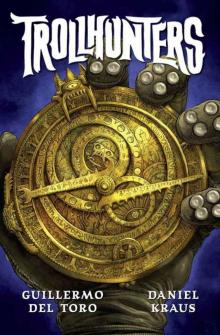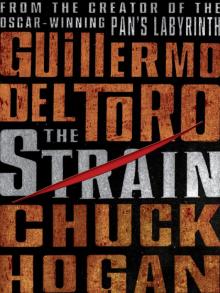- Home
- Guillermo Del Toro
The Strain Page 2
The Strain Read online
Page 2
Terminal 3 Tarmac
LORENZA RUIZ was on her way out to the gate, driving a baggage conveyor, basically a hydraulic ramp on wheels. When 753 didn’t show around the corner as expected, Lo rolled out farther for a little peek, as she was due her break soon. She wore protective headphones, a Mets hoodie underneath her reflective vest, goggles—that runway grit was a bitch—with her orange marshaling batons lying next to her hip, on the seat.
What in the hell?
She pulled off her goggles as though needing to see it with her bare eyes. There it was, a Regis 777, a big boy, one of the new ones on the fleet, sitting out on Foxtrot in darkness. Total darkness, even the nav lights on the wings. All she saw was the smooth, tubular surface of the fuselage and wings glowing faintly under the landing lights of approaching planes. One of them, Lufthansa 1567, missing a collision with its landing gear by a mere foot.
“Jesus Santisimo!”
She called it in.
“We’re already on our way,” said her supervisor. “Crow’s nest wants you to roll out and take a look.”
“Me?” Lo said.
She frowned. That’s what you get for curiosity. So she went, following the service lane out from the passenger terminal, crossing the taxiway lines painted onto the apron. She was a little nervous, and very watchful, having never driven out this far before. The FAA had strict rules about how far out the conveyors and baggage trailers were supposed to go.
She turned past the blue guide lamps edging the taxiway. The plane appeared to have been shut down completely, stem to stern. No beacon light, no anticollision light, no lights in the cabin windows. Usually, even from the ground, thirty feet below, through the tiny windshield like eyes slanting over the characteristic Boeing nose, you could see up and inside the cockpit, the overhead switch panel and the instrument lights glowing darkroom red. But there were no lights at all.
Lo idled ten yards back from the tip of the long left wing. You work the tarmac long enough—Lo had eight years in now, longer than both of her marriages put together—you pick up a few things. The trailing edge flaps and the ailerons—the spoiler panels on the back sides of the wings—were all straight up like Paula Abdul, which is how pilots set them after runway touchdown. The turbojets were quiet and still, and they usually took a while to stop chewing air even after switch off, sucking in grit and bugs like great ravenous vacuums. So this big baby had come in clean and set down all nice and easy and gotten this far before—lights out.
Even more alarmingly, if it had been cleared for landing, whatever had gone wrong happened in the space of two, maybe three minutes. What can go wrong that fast?
Lo pulled a little bit closer, rolling in behind the wing. If those turbofans were to start up all of a sudden, she didn’t want to get sucked in and shredded like some Canadian goose. She drove near the freight hold, the area of the plane she was best acquainted with, down toward the tail, stopping beneath the rear exit door. She set the locking brake and worked the stick that raised her ramp, which at its height topped out at about a thirty-degree incline. Not enough, but still. She got out, reached back in for her batons, and walked up the ramp toward the dead airplane.
Dead? Why did she think that? The thing had never been alive—
But for a moment, Lorenza thought of the image of a large, rotting corpse, a beached whale. That was what the plane looked like to her: a festering carcass; a dying leviathan.
The wind stopped as she neared the top, and you have to understand one thing about the climate out on the apron at JFK: the wind never stops. As in never ever. It is always windy out on the tarmac, with the planes coming in and the salt marsh and the friggin’ Atlantic Ocean just on the other side of Rockaway. But all of a sudden it got real silent—so silent that Lo pulled down her big-muff headphones, just to be certain. She thought she heard pounding coming from inside the plane, but realized it was just the beating of her own heart. She turned on her flashlight and trained it on the right flank of the plane.
Following the circular splash of her beam, she could see that the fuselage was still slick and pearly from its descent, smelling like spring rain. She shined her light on the long row of windows. Every interior shade was pulled down.
That was strange. She was spooked now. Majorly spooked. Dwarfed by a massive, $250-million, 383-ton flying machine, she had a fleeting yet palpable and cold sensation of standing in the presence of a dragon-like beast. A sleeping demon only pretending to be asleep, yet capable, at any moment, of opening its eyes and its terrible mouth. An electrically psychic moment, a chill running through her with the force of a reverse orgasm, everything tightening, knotting up.
Then she noticed that one of the shades was up now. The fine hairs went so prickly on the back of her neck, she put her hand there to console them, like soothing a jumpy pet. She had missed seeing that shade before. It had always been up—always.
Maybe…
Inside the plane, the darkness stirred. And Lo felt as if something were observing her from within it.
She whimpered, just like a child, but couldn’t help it. She was paralyzed. A throbbing rush of blood, rising as though commanded, tightened her throat…
And she understood it then, unequivocally: something in there was going to eat her…
The gusting wind started up again, as though it had never paused, and Lo didn’t need any more prompting. She backed down the ramp and jumped inside her conveyor, putting it in reverse with the alert beeping and her ramp still up. The crunching noise was one of the blue taxiway lights beneath her treads as she sped away, half on and half off the grass, toward the approaching lights of half a dozen emergency vehicles.
JFK International Control Tower
CALVIN BUSS had switched to a different headset, and was giving orders as set forth in the FAA national playbook for taxiway incursions. All arrivals and departures were halted in a five-mile airspace around JFK. This meant that volume was stacking up fast. Calvin canceled breaks and ordered every on-shift controller to try to raise Flight 753 on every available frequency. It was as close to chaos in the JFK tower as Jimmy the Bishop had ever seen.
Port Authority officials—guys in suits muttering into Nextels—gathered at his back. Never a good sign. Funny how people naturally assemble when faced with the unexplained.
Jimmy the Bishop tried his call again, to no avail.
One suit asked him, “Hijack signal?”
“No,” said Jimmy the Bishop. “Nothing.”
“No fire alarm?”
“Of course not.”
“No cockpit door alarm?” said another.
Jimmy the Bishop saw that they had entered the “stupid questions” phase of the investigation. He summoned the patience and good judgment that made him a successful air-traffic controller. “She came in smooth and set down soft. Regis 7-5-3 confirmed the gate assignment and turned off the runway. I terminated radar and transitioned it over to ASDE.”
Calvin said, one hand over his earphone mic, “Maybe the pilot had to shut down?”
“Maybe,” said Jimmy the Bishop. “Or maybe it shut down on him.”
A suit said, “Then why haven’t they opened a door?”
Jimmy the Bishop’s mind was already spinning on that. Passengers, as a rule, won’t sit still for a minute longer than they had to. The previous week, a jetBlue arriving from Florida had very nearly undergone a mutiny, and that was over stale bagels. Here, these people had been sitting tight for, what—maybe fifteen minutes. Completely in the dark.
Jimmy the Bishop said, “It’s got to be starting to get hot in there. If the electrical is shut down, there’s no air circulating inside. No ventilation.”
“So what the hell are they waiting for?” said another suit.
Jimmy the Bishop felt everyone’s anxiety going up. That hole in your gut when you realize that something is about to happen, something really, really wrong.
“What if they can’t move?” he muttered before he could stop himself from speakin
g.
“A hostage situation? Is that what you mean?” asked the suit.
The Bishop nodded quietly…but he wasn’t thinking that. For whatever reason, all he could think was…souls.
Taxiway Foxtrot
THE PORT AUTHORITY’S aircraft rescue firefighters went out on a standard airliner distress deployment, six vehicles including the fuel spill foamer, pumper, and aerial ladder truck. They pulled up at the stuck baggage conveyor before the blue lamps edging Foxtrot. Captain Sean Navarro hopped off the back step of the ladder truck, standing there in his helmet and fire suit before the dead plane. The rescue vehicles’ lights flashing against the fuselage imbued the aircraft with a fake red pulse. It looked like an empty plane set out for a nighttime training drill.
Captain Navarro went up to the front of the truck and climbed in with the driver, Benny Chufer. “Call in to maintenance and get those staging lights out here. Then pull up behind the wing.”
Benny said, “Our orders are to hang back.”
Captain Navarro said, “That’s a plane full of people there. We’re not paid to be glorified road flares. We’re paid to save lives.”
Benny shrugged and did as the cap told him. Captain Navarro climbed back out of the rig and up onto the roof, and Benny raised the boom just enough to get him up on the wing. Captain Navarro switched on his flashlight and stepped over the trailing edge between the two raised flaps, his boot landing right where it said, in bold black lettering, DON’T STEP HERE.
He walked along the broadening wing, twenty feet above the tarmac. He went to the over-wing exit, the only door on the aircraft installed with an exterior emergency release. There was a small, unshaded window set in the door, and he tried to peer through, past the beads of condensation inside the double-thick glass, seeing nothing inside except more darkness. It had to be as stifling as an iron lung in there.
Why weren’t they calling out for help? Why wasn’t he hearing any movement inside? If still pressurized, then the plane was airtight. Those passengers were running out of oxygen.
With his fire gloves on, he pushed in the twin red flaps and pulled the door handle out from its recess. He rotated it in the direction of the arrows, nearly 180 degrees, and tugged. The door should have popped outward then, but it would not open. He pulled again, but knew immediately that his effort was useless—no give whatsoever. There was no way it could have been stuck from the inside. The handle must have jammed. Or else something was holding it from the inside.
He went back down wing to the ladder top. He saw an orange utility light spinning, an airport cart on its way out from the international terminal. Closer, he saw it was driven by blue-jacketed agents of the Transportation Security Administration.
“Here we go,” muttered Captain Navarro, starting down the ladder.
There were five of them, each one introducing himself in turn, but Captain Navarro didn’t waste any effort trying to remember names. He had come to the plane with fire engines and foaming equipment; they came with laptops and mobile handhelds. For a while he just stood and listened while they talked into their devices and over each other:
“We need to think long and hard before we push the Homeland Security button here. Nobody wants a shit storm for nothing.”
“We don’t even know what we have. You ring that bell and scramble fighters up here from Otis Air Force Base, you’re talking about panicking the entire eastern seaboard.”
“If it is a bomb, they waited until the last possible moment.”
“Explode it on U.S. soil, maybe.”
“Maybe they’re playing dead for a while. Staying radio dark. Luring us closer. Waiting for the media.”
One guy was reading from his phone. “I have the flight originating from Tegel, in Berlin.”
Another spoke into his. “I want someone on the ground in Germany who sprechen ze English. We need to know if they’ve seen any suspicious activity there, any breaches. Also, we need a primer on their baggage-handling procedures.”
Another ordered: “Check the flight plan and reclear the passenger manifest. Yes—every name, run them again. This time accounting for spelling variations.”
“Okay,” said another, reading from his handheld. “Full specs. Plane reg is N323RG. Boeing 777–200LR. Most recent transit check was four days ago, at Atlanta Hartsfield. Replaced a worn duct slider on the left engine’s thrust reverser, and a worn mount bushing on the right. Deferred repair of a dent in the left-aft inboard flap assembly due to flight schedule. Bottom line—she got a clean bill of health.”
“Triple sevens are new orders, aren’t they? A year or two out?”
“Three hundred and one max capacity. This flight boarded two ten. A hundred and ninety-nine passengers, two pilots, nine cabin crew.”
“Any unticketed?” That meant infants.
“I’m showing no.”
“Classic tactic,” said the one focused on terror. “Create a disturbance, draw first responders, gain an audience—then detonate for max impact.”
“If so, then we’re already dead.”
They looked at each other uncomfortably.
“We need to pull these rescue vehicles back. Who was that fool up there stomping on the wing?”
Captain Navarro edged forward, surprising them with a response. “That was me.”
“Ah. Well.” The guy coughed once into his fist. “That’s maintenance personnel only up there, Captain. FAA regs.”
“I know it.”
“Well? What’d you see? Anything?”
Navarro said, “Nothing. Saw nothing, heard nothing. All the window shades are drawn down.”
“Drawn down, you say? All of them?”
“All of them.”
“Did you try the over-wing exit?”
“I did indeed.”
“And?”
“It was stuck.”
“Stuck? That’s impossible.”
“It’s stuck,” said Captain Navarro, showing more patience with these five than he did with his own kids.
The senior man stepped away to make a call. Captain Navarro looked at the others. “So what are we going to do here, then?”
“That’s what we’re waiting to find out.”
“Waiting to find out? You have how many passengers on this plane? How many 911 calls have they made?”
One man shook his head. “No mobile 911 calls from the plane yet.”
“Yet?” said Captain Navarro.
The guy next to him said, “Zero for one-ninety-nine. Not good.”
“Not good at all.”
Captain Navarro looked at them in amazement. “We have to do something, and now. I don’t need permission to grab a fire ax and start smashing in windows when people are dead or dying in there. There is no air inside that plane.”
The senior man came back from his phone call. “They’re bringing out the torch now. We’re cutting her open.”
Dark Harbor, Virginia
CHESAPEAKE BAY, black and churning at that late hour.
Inside the glassed-in patio of the main house, on a scenic bluff overlooking the bay, a man reclined in a specially made medical chair. The lights were dimmed for his comfort as well as for modesty. The industrial thermostats, of which there were three for this room alone, maintained a temperature of sixty-two degrees Fahrenheit. Stravinsky played quietly, The Rite of Spring, piped in through discreet speakers to obscure the relentless shushing pump of the dialysis machine.
A faint plume of breath emerged from his mouth. An onlooker might have believed the man near death. Might have thought they were witnessing the last days or weeks of what was, judging by the sprawling seventeen-acre estate, a dramatically successful life. Might even have remarked on the irony of a man of such obvious wealth and position meeting the same end as a pauper.
Only, Eldritch Palmer was not at the end. He was in his seventy-sixth year, and he had no intention of giving up on anything. Nothing at all.
The esteemed investor, businessman, theologian,
and high-powered confidant had been undergoing the same procedure for three to four hours every evening for the past seven years of his life. His health was frail and yet manageable, overseen by round-the-clock physicians and aided by hospital-grade medical equipment purchased for his private, in-home use.
Wealthy people can afford excellent health care, and they can also afford to be eccentric. Eldritch Palmer kept his peculiarities hidden from public view, even from his inner circle. The man had never married. He had never sired an heir. And so a major topic of speculation about Palmer was what plans he might have for his vast fortune after his death. He had no second-in-command at his primary investment entity, the Stoneheart Group. He had no public affiliation with any foundations or charities, unlike the two men jockeying for number one with him on the annual Forbes list of the world’s richest Americans, Microsoft founder Bill Gates and Berkshire Hathaway investor Warren Buffett. (If certain gold reserves in South America and other holdings by shadow corporations in Africa were factored into Forbes’s accounting, Palmer alone would hold the top spot on the list.) Palmer had never even drafted a will, an estate-planning lapse unthinkable for a man with even one one-thousandth of his wealth and treasure.
But Eldritch Palmer was, quite simply, not planning to die.
Hemodialysis is a procedure in which blood is removed from the body through a system of tubing, ultrafiltered through a dialyzer, or artificial kidney, and then returned to the body cleansed of waste products and impurities. Ingoing and outgoing needles are inserted into a synthetic arteriovenous graft semipermanently installed in the forearm. The machine for this procedure was a state-of-the-art Fresenius model, continuously monitoring Palmer’s critical parameters and alerting Mr. Fitzwilliam, never more than two rooms away, of any readings outside the normal range.
Loyal investors were accustomed to Palmer’s perpetually gaunt appearance. It had essentially become his trademark, an ironic symbol of his monetary strength, that such a delicate, ashen-looking man should wield such power and influence in both international finance and politics. His legion of faithful investors numbered thirty thousand strong, a financially elite bloc of people: the buy-in was two million dollars, and many who had invested with Palmer for decades were worth mid-nine figures. The buying power of his Stoneheart Group gave him enormous economic leverage, which he put to effective and occasionally ruthless use.

 Cabinet of Curiosities
Cabinet of Curiosities The Complete Strain Trilogy
The Complete Strain Trilogy Trollhunters
Trollhunters The Night Eternal
The Night Eternal The Fall
The Fall The Shape of Water
The Shape of Water The Strain
The Strain The Fall tst-2
The Fall tst-2 Guillermo del Toro's Cabinet of Curiosities
Guillermo del Toro's Cabinet of Curiosities The Strain tst-1
The Strain tst-1 The Strain, the Fall, the Night Eternal
The Strain, the Fall, the Night Eternal